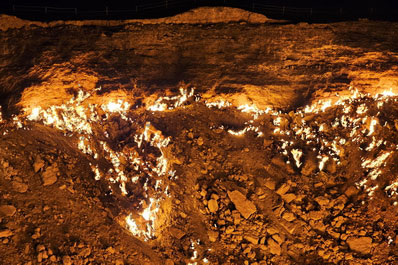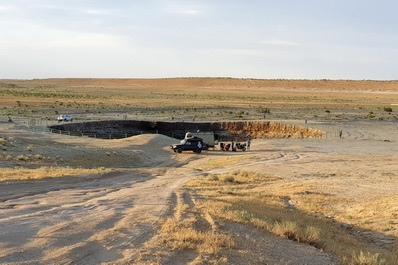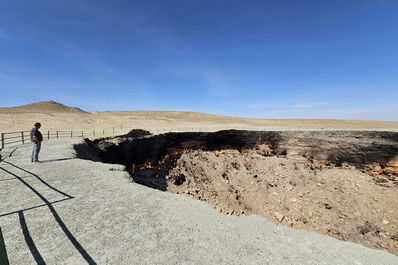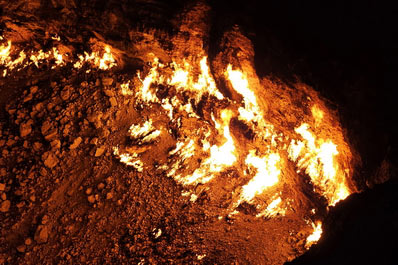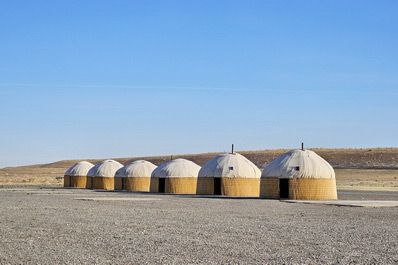Darvaza Gas Crater, Turkmenistan

Diameter: 60 meters
Greatest Depth: 20 meters
Temperature at the Bottom: +800°C
Time Zone: UTC+5
You don't have to die to see hell, just travel to Turkmenistan and visit the Darvaza Gas Crater, famously known as the Gates of Hell. This fiery spectacle is a massive pit where hundreds of flames burn at the bottom, spewing jets of searing air into the atmosphere. Standing on the edge of the crater can be a terrifying experience, but an irresistible voice beckons you to "Look in! Many visitors find themselves in awe, gazing into the depths of the underworld amidst the vast, lifeless desert.
Darvaza Tours
The Darvaza gas crater is one of Turkmenistan's most famous attractions, drawing thousands of tourists each year to witness this natural phenomenon firsthand. Visitors flock to take stunning and unique photographs and selfies against the backdrop of this extraordinary site. For those wishing to fully absorb the desert experience, there are opportunities to camp or stay in yurt camps near the crater. You can also explore other fascinating sites during your trip to Darvaza, such as the mud and water craters just a few kilometers to the south.
History of Darvaza
The Darvaza gas crater, meaning “gate” in Turkic languages, emerged in 1971, a curious product of human error or perhaps a quirk of nature. Over 50 years ago, geological prospecting was underway in the Karakum Desert when an incident near the village of Darvaza led to the formation of a massive hole, measuring 60 meters in diameter and 20 meters deep, atop natural gas deposits. Fortunately, there were no injuries, and all equipment was successfully extracted from the crater. However, the gas seeping from the bottom created a hazardous atmosphere, prompting those in charge to ignite the crater, believing the flames would extinguish within a few days. They were mistaken, as the flames have continued to blaze for over half a century.
In 2004, the nearby village of Darvaza was abandoned and subsequently demolished due to the crater's impact on the area. Despite plans initiated by the President of Turkmenistan in 2010 and 2022 to extinguish the flames, these proposals were never realized, as efforts to manage this unique natural phenomenon faced numerous challenges. In 2013, adventurer and researcher George Koronis ventured into the depths of the crater, uncovering bacteria that thrive at high temperatures, further emphasizing the crater's extraordinary nature and scientific significance.
How to Get to Darvaza
Located in the heart of the Karakum Desert, reaching the Darvaza gas crater requires a full day's travel, as road conditions can be poor in places, and the last few kilometers are over sandy terrain. The crater is located 270 kilometers from Ashgabat and about 300 kilometers (about 186.41 mi) from Dashoguz, with each trip taking about 4 hours. To visit the crater, you should travel to one of these cities first.
During the day, the Darvaza crater resembles an ordinary giant pit, but after sunset it transforms into an epic spectacle. If you're not planning to stay overnight, it's a good idea to arrive at the gas crater about 4 hours before sunset to take full advantage of its breathtaking beauty.
You can also reach Darvaza from Uzbekistan by crossing the border. For example, the journey from Khiva to Dashoguz is 70 kilometres via the Shavat-Dashoguz checkpoint, which will add 2 hours to your travel time.
Best Time to Visit Darvaza
The climate of the Karakum Desert is sharply continental, with winter temperatures ranging from 3 to 10 degrees Celsius, often dropping below zero at night. Summer, on the other hand, can be very hot, with temperatures soaring to 50 degrees Celsius. Precipitation is infrequent, falling mostly during the winter months.
For those planning to visit the Darvaza crater, it is essential to consider these climatic nuances and choose the most comfortable months for your trip - March, April, September and October are ideal choices. While it is certainly possible to visit the crater in both winter and summer, travelers need to be prepared by bringing either warm clothing for the cold months or protective gear to shield themselves from the scorching sun in the heat of summer.
Meals and Accommodation at Darvaza
Just 500 metres from the crater is a yurt camp where tourists can enjoy food, drink and comfortable accommodation in traditional-style yurts with beds. The camp has an indoor restaurant for inclement weather and a summer café with reed roofs to provide a cosy atmosphere for guests. However, it's essential to book your accommodation at the yurt camp in advance to take advantage of these facilities.
For travelers who are planning to visit Darvaza without staying overnight, or for those who intend to pitch their own tents, it's important to prepare in advance with food and water. Relying on nearby settlements or petrol stations along the way is not advisable, so it's best to buy all the necessary food, lunchboxes and water before leaving Ashgabat or Dashoguz.
Safety at Darvaza
When visiting Darvaza, safety precautions should focus on three key areas: the crater walls, the desert environment and the remoteness from civilisation.
The edges of the Darvaza gas crater are steep and unstable, so it is important to follow safety guidelines. The area is surrounded by a barrier that should not be crossed, a rule that also applies to the mud and water craters in the vicinity.
The Karakum Desert is home to various snakes, spiders and scorpions, which are particularly active at night during the hottest months from May to September. Before settling down for the night, check your campsite, take your shoes inside the yurt or tent and check any items left outside in the morning. Avoid searching for desert fauna or setting up photo-hunting decoys. If bitten, be aware that medical help is a four-hour drive away.
Darvaza is dozens of kilometres away from the nearest settlements, so it's important to bring plenty of supplies with you in case of any unforeseen circumstances. During the peak tourist season, several vehicles may gather for the evening, and although a yurt camp is available, it's best not to rely on others for assistance. If you're travelling independently, don't travel in a single vehicle, be prepared for possible repairs in the field and consider carrying a satellite phone for emergencies.
Remember that the desert can be extremely hot, so it's important to carry plenty of water. Unexpected events can occur, such as a car radiator boiling over or health problems, so it's wise to be prepared. Wearing hats and protective clothing will help prevent sunburn and ensure a safer experience in this rugged landscape.


